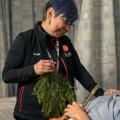Anal fissures
An overview of Providence Health Care’s services and resources for adults experiencing anal fissures.
Overview
An anal fissure is a small tear or ulcer (open sore) in the lining of the anus.
Anal fissures are common and usually mild. However, they can be painful. They are most often caused by passing hard stools. They can also cause bleeding during bowel movements.
Sometimes people confuse anal fissures with hemorrhoids because of their similar symptoms.
Contact
Pacific Gastroenterology Associates
770 – 1190 Hornby Street
Vancouver, BC, V6Z 2K5
Diagnosis & testing
To diagnose an anal fissure, a health care professional will look at your rectal area. They will look for tears in the rectal lining. They will be respectful and sensitive to your boundaries during this exam.
Anal fissures are acute if they last for a short time. They are chronic if they last for more than eight weeks.
Treatment & management
Most acute anal fissures go away on their own within a few days or weeks with home treatment.
Home treatment includes:
- Eating lots of fibre and drinking plenty of fluid to soften your stools. You can also take an over-the-counter fibre supplement, such as Metamucil.
- Soaking your anal region in warm water using a sitz bath or bathtub. A sitz bath is a warm, shallow bath you sit in to relieve discomfort in your anal region. You should do this for 10 to 20 minutes several times a day.
- We may also recommend stool softeners or laxatives.
If your anal fissure does not improve, we might prescribe mediation. Most medications for anal fissures help relax the anal sphincter.
Typical medicines we prescribe at Providence Health Care to treat anal fissures include:
- Nitroglycerin ointment: Nitroglycerin ointment is a topical medicine that is applied to the surface of your skin. The ointment relaxes the anal sphincter and increases blood flow to the anal region.
Nitroglycerin is the most common medication to treat an anal fissure.
- Calcium channel blockers: Your doctor may prescribe calcium channel blockers if nitroglycerin ointment does not work. Calcium channel blockers also relax the muscles in your anus and increase blood flow. Examples of calcium channel blockers are diltiazem and nifedipinemay.
A chronic anal fissure typically heals within 6 to 12 weeks with medical treatment.
Surgery
You may need surgery if your chronic anal fissure is severe or does not go away with medical treatment.
We perform surgery for anal fissures at St. Paul's Hospital. The surgery for anal fissures is called a lateral internal sphincterotomy. It is a minor procedure that usually takes 30 minutes.
Lateral internal sphincterotomy is a quick outpatient procedure. You can go home after you have the procedure. Our surgeons insert a tube into your anus. They use tools to cut your sphincter and relieve tension.
Support services
Providence Health Care offers a variety of services to support those we care for. The following services may be of use or benefit to you and your families.
Support for Indigenous Peoples
The Indigenous Wellness Liaison Team is here to support your health journey. Team members offer cultural support and healthcare advocacy. Learn more below or call them at 604-682-2344,62937 or email IWL@providencehealth.bc.ca.
Education & resources
Clinical trials & research
Advances in treatments for gastrointestinal diseases are all thanks to medical research. Please ask us about our research programs if you’re interested.
By taking part in research, you can help us all learn more about advancing health outcomes and find better ways to help people like you live and thrive. Even if you don't benefit directly, your participation can help care for future patients.
For more information about GI-related research at Providence Health Care, ask your care team or visit Providence Research.
